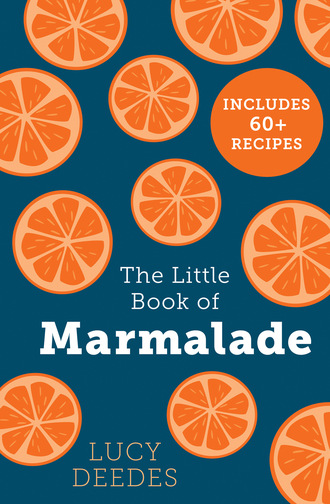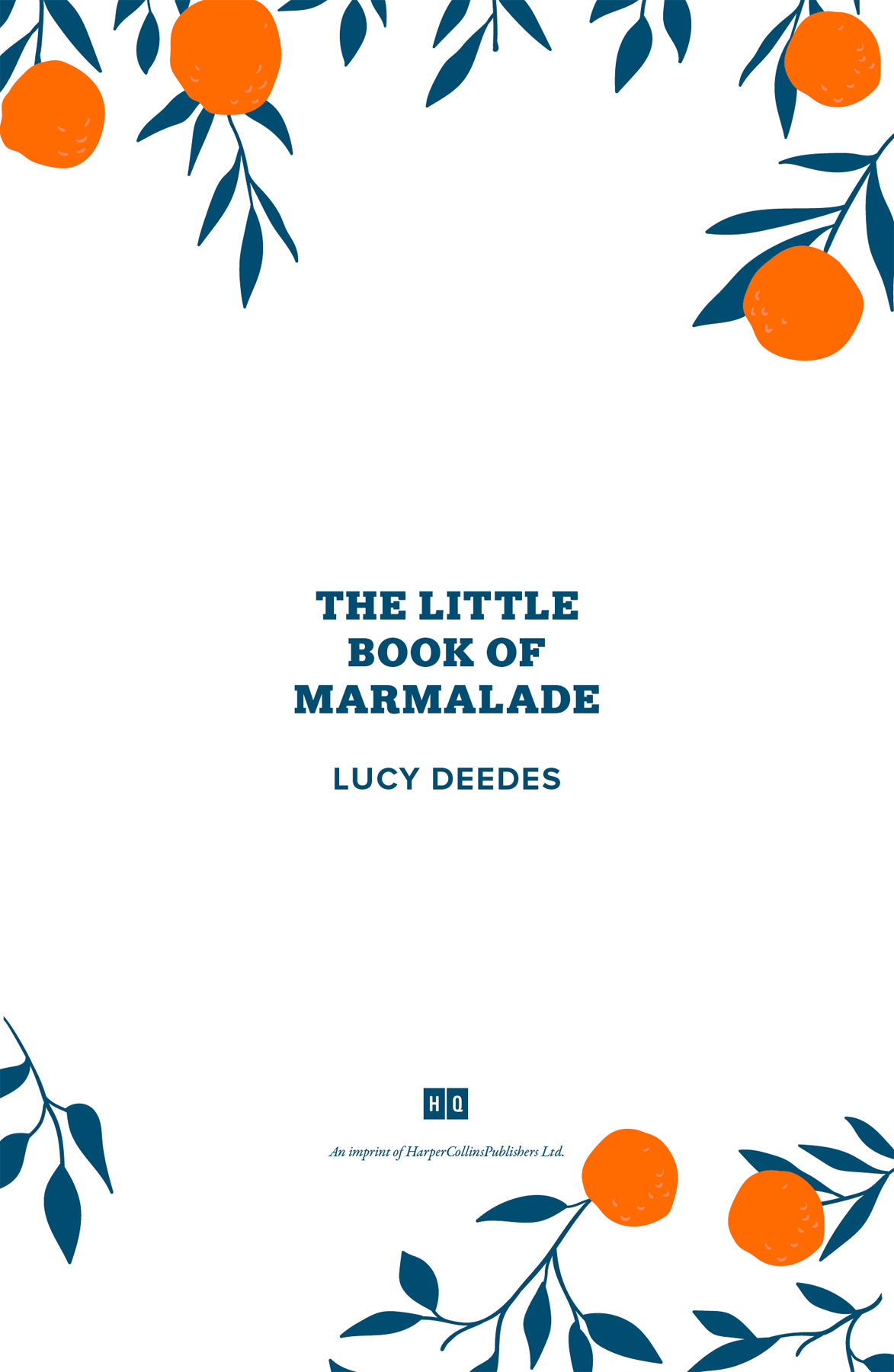
Полная версия
The Little Book of Marmalade


COPYRIGHT
HQ
An imprint of HarperCollinsPublishers Ltd
1 London Bridge Street
London SE1 9GF
First published in Great Britain by HQ
An imprint of HarperCollinsPublishers Ltd 2020
Copyright © Lucy Deedes 2020
Illustrations ©Alenka Karabanova /Shutterstock
Book Design: Steve Wells
Lucy Deedes asserts the moral right to be identified as the author of this work. A catalogue record for this book is available from the British Library.
Hardback ISBN: 9780008378455
eBook ISBN: 9780008378462
All rights reserved. No part of this publication may be reproduced, stored in a retrieval system, or transmitted, in any form or by any means, electronic, mechanical, photocopying, recording or otherwise, without the prior permission of the publishers.
NOTE TO READERS
This ebook contains the following accessibility features which, if supported by your device, can be accessed via your ereader/accessibility settings:
Change of font size and line height
Change of background and font colours
Change of font
Change justification
Text to speech
Page numbers taken from the following print edition: ISBN 9780008378455



Cover
Title Page
Copyright
Note to Readers
Introduction
Handy tips before you begin
WINTER
DECEMBER
Marmalade with Honey (no sugar)
Reduced-Sugar Marmalade
Marmalade Rum Sour Cocktail
Lambs’ Liver with Orange
Orange Drizzle Cake
Chocolate and Marmalade Tart
JANUARY
Seville Orange Marmalade
Butterflied Leg of Lamb with Seville Orange Marinade
Maud’s Simple Sourdough Loaf
Orange Gin
Pappardelle with Prosciutto and Seville Oranges
Tudor Quince Marmalade
FEBRUARY
Dark Bitter Marmalade
Marmalade Mojito
Roast Pheasant with Marmalade
Beef Stew with Dumplings
Bitter Orange and Cardamom Cocktail
Vegan Orange Cookies
SPRING
MARCH
Marmalade Whisky Sour Cocktail
Pink Grapefruit Marmalade
Candied Seville Orange Peel
Custard Tarts with Candied Seville Oranges
Chicken with Seville Oranges
APRIL
Bertie’s Four-Fruit Marmalade
Marmalade Vodka
Florentines
Pork Chops with Marmalade, Fennel and Rosemary
My Aunt Margaret’s Shortbread
MAY
Ginger Marmalade
Marmalade French Toast
Scallops with Spinach and Seville Oranges
Cantuccini with Orange and Pistachio
SUMMER
JUNE
Ally’s Marmalade Ice Cream
Lime Marmalade
Warm Duck Salad
JULY
Salmon with Marmalade Glaze
Lemon and Earl Grey Marmalade
Marmalade Cookies
Chicken with Marmalade
Hot Marmalade Soufflés
AUGUST
Bitter Orange Marinade (for chicken and pork)
Lavender Marmalade
Baked Coconut Chicken with Marmalade Sauce
Cheesecake with Marmalade
AUTUMN
SEPTEMBER
Danish Hyben Marmelade
Bacon or Sausage Sandwiches
Lamb Shanks with Marmalade
Jaffa Cakes
OCTOBER
Chocolate and Orange Fridge Cake
Chai Mandarin Marmalade
Venison Wellington with Plum and Marmalade Sauce
White Fish with Seville Orange Hollandaise
Marmalade Bread and Butter Pudding
Membrillo
NOVEMBER
Pumpkin Marmalade
Rum Marmalade
Baked Ham with Marmalade Glaze
Quince Jelly
Orange Macarons
Marmalade Treacle Tart
Marmalade Fruit Cake
Acknowledgements
About the Publisher
INTRODUCTION
Like many of us, I learned to cook by ‘helping’ my mother, or rather by sitting on the dented lid of the Aga reading aloud to her while she worked. The kitchen was the warmest place to be and there were plums and bullaces to be bottled, bread to be made and butter to be churned. Orphaned lambs snuggled up to the stove and the Jack Russell terriers mooched about picking up crumbs. When Seville oranges arrived in the shops for those few weeks in January, my mother usually froze them whole so that she could make marmalade later on when she had time. There was too much to do in those short winter days when the sheep were lambing, the ponies were in stables and the Jersey cows’ trough was freezing over. I don’t think she actively taught me to cook but I must have absorbed something in between the pages of The Code of the Woosters.
Marmalade was historically – and should still be – regarded as a luxury food. It was made from expensive imported items and treated with all the reverence it deserves. It has been with us for hundreds of years in one form or another – as a Portuguese sweetmeat, an after-dinner digestif, as a rich quince slab to be cut into squares like Turkish delight, an aphrodisiac – before it turned into the most famous breakfast ingredient ever. And it has been a breakfast necessity for over 200 years for everyone from the Queen (who reputedly has Tiptree Orange Marmalade on her white breakfast toast) to James Bond; every well-run household from the reign of Queen Victoria onwards has made sure the larder was well-stocked with homemade marmalade.
We all know the sort of marmalade we like just as we know how we like our coffee. Some people like a clear jelly, with just a few wafers of peel hanging like seahorses in the jar; some a firm orange mixture with no extras. Some refuse to touch it unless it’s a dark, raffish paste, boiled down almost to toffee with a passing suggestion of booze about it.
Part of the appeal of marmalade is its mysterious marriage between sweet and bitter; finding that balance is certainly what makes it so rewarding to make and also why it gives such a kick to almost anything to which you add it.
Some regular marmalade makers stick to the tried-and-tested Grandmother’s Recipe: The Receipt Book, a precious document with sticky pages, fearing that if they go off-piste and introduce an exotic new ingredient it will all go terribly wrong.
Embarking on marmalade-making for the first time can be unnerving, but it is not difficult: it is after all a combination of just three ingredients: citrus fruit, sugar and water. Having said that, there are important steps to follow and it can occasionally surprise you and refuse to cooperate. Even now, I find that sometimes the rolling, hissing boil doesn’t happen. (What! No rolling boil?) It skips that bit, as a joke. Or you would swear it was ready, but then it won’t set in the jars. (Relax, leave it overnight.)
I had a few years of ill health when much was out of my control, and that was when I started to appreciate how soothing it is to make marmalade, how very satisfying to produce something good to look at and good to eat, which almost everyone is delighted to receive as a present. Perhaps there was a subconscious vote of confidence for the future in preserving fruit and storing it for later; I didn’t know T.E. Lawrence’s ‘Happiness is a by-product of absorption’ then, but there is a sense of peace and contentment that descends when you have an absorbing physical task to do. Homemade marmalade is ‘slow’, not fast food, and it takes a bit of concentration, but the results are worth the effort.
You may want to make enough in January to last you for the whole year; or you might prefer to make a few jars here and there, throughout the year, using a handful of frozen oranges or experimenting with other citrus fruit like limes and grapefruit, and adding herbs, like thyme or rosemary in the summer, lavender flowers or ginger in July. Cloves and warming spices are delicious in a pre-Christmas batch. I personally think that the exciting sharpness of marmalade is at its very best when the marmalade is fresh, but however long you keep it before you eat it, the most gratifying thing is that every jar you make will be uniquely your own.
The recipes in this book are my own, handed down from my mother and many generous and accomplished cooks, as well as borrowed favourites from friends. They’ve been tried and tested over the years, and tinkered with along the way to suit more modern tastes. Methods vary slightly from one recipe to another, but isn’t that the beauty of home cooking? I hope you enjoy making marmalade whatever the season, and that you find your favourite among the many in this special collection.
HANDY TIPS BEFORE YOU BEGIN
A FEW CLUES
1 1.Buy organic, unwaxed citrus fruit if you can because you are eating the whole fruit, and non-organic fruit will have been well doused with sprays. Ask your greengrocer. Discard any dodgy-looking or bruised fruit.
2 2.Use fresh or frozen oranges. Seville oranges freeze brilliantly, but freezing does weaken the pectin over time so it’s a good idea to add fresh citrus fruit – lemons, grapefruit, limes – when you’re cooking with frozen oranges.
3 3.Use granulated or caster sugar, or soft dark sugar for a more deeply coloured marmalade (or try preserving sugar as I do; it gives the clearest appearance). Use brown sugar only if you want a darker, stickier marmalade.
4 4.Make sure your jars and lids are sparkling clean (see here for how to sterilise).
5 5.Add water to about 2.3 times the weight of whole fruit, but less for a darker, stickier marmalade – more like 1.5 to 1 (1.5 litres of water to 1kg fruit).
6 6.Work to the ratio of 4:3 cooked pulp to sugar, and 2:1 for dark, bitter marmalade as it contains treacle (otherwise it would be far too sweet), but by all means go for 1:1 should you wish. Play with the levels if you want less or more sugar.
7 7.Use a sugar thermometer to test for setting point: it is ready when it reaches 105°C. You will soon get to know what the marmalade looks and sounds like when it’s ready – by the seething noise of a rolling boil and the way the marmalade hangs on the spoon like icicles when it’s nearly done. Otherwise, use the wrinkle test (see here).
8 8.It’s very important to leave the marmalade to settle before you pour it into the warm jars: the mixture needs to congeal slightly so that the peel is held suspended in the jelly. If you pot up too fast, the peel will swim up to the top of the jar. And I always use a scalded plastic or Pyrex jug to pot up the marmalade; it makes less mess than a ladle.
9 9.Fill the jars to the very top, but not so it will touch the lids, and don’t bother with waxed paper discs – you don’t need them with screw-top lids.
10 10.Store in a cool and dark place, and keep in the fridge once opened.
USING AN ELECTRIC JUICER
Not only is it quicker and easier, but an electric juicer will strip off all the membranes as it juices, leaving just the pith behind. If you are juicing by hand, you will need to tug off these membranes to add to the muslin bag.
SOAKING THE FRUIT
If time allows, it is a good idea to soak the chopped oranges and the muslin bag of pips overnight because the all-important pectin which will set your marmalade is in the skin and pips, not the orange juice and flesh, and a long soak will thoroughly extract it. It will also soften the tough skins and reduce cooking time. I also always leave the cooked fruit to soak overnight or for a few hours to draw out all the possible pectin. But if you don’t have the time, then just crack on without soaking.
STERILISING JARS AND LIDS
Put the jars and lids through a hot dishwasher cycle and then onto a baking tray in a 150°C/130°C fan/Gas 2 oven (jars for 15 minutes, lids for 5) once the marmalade reaches 102°C–103°C, so they’re still warm when you fill them.
THE WRINKLE TEST
The traditional way of testing for a set is to leave a saucer or ramekin in the fridge to get cold, put a spoonful of marmalade on it, leave for a minute and see if it wrinkles when you push your finger through it. Remove the marmalade from the heat while you do this, and replace on the heat if it’s not yet done, repeating the process until it reaches setting point.
SEALING THE JARS
Put the lids on immediately the jar is filled but only loosely. Return the jars to the 150°C/130°C fan/Gas 2 oven for 5 minutes and then tighten the lids for a good seal before leaving to cool.

Winter is usually a time for hibernation. As the nights draw in and the temperature drops, there’s nothing better than to cosy up at home. So it’s the perfect opportunity to work some marmalade magic in the kitchen. Marmalade in winter is like nothing else. Seville oranges from Spain are harvested from November onwards and they’re sometimes available before Christmas to make the perfect sticky glaze to any Christmas centrepiece.

MARMALADE WITH HONEY (NO SUGAR)
This is worth a try if you want to be sugar-free. You don’t get the set, and the finished result is more of a compote than a jelly, but it has a very good, fresh taste.
Makes 2 small jars
1 Seville orange
1 clementine or mandarin
3 large sweet oranges
2 tbsp good-quality honey
Peel the Seville orange, clementine or mandarin and one of the sweet oranges. Break the fruit into segments, removing the pips and as much of the white pith as you can. Whizz the fruit pieces to a purée in a food processor.
Shave off any excess pith on the inside of the peels and slice or chop the peel finely. Put the pips, membranes and excess pith in a muslin bag and tie a knot in the top.
Juice the remaining 2 oranges and add the juice to a preserving pan with the fruit purée, the sliced peel and the muslin bag. Cook on a low heat for about 10–15 minutes until the peel is soft.
Add the honey, stir it in and simmer for another 10 minutes until the mixture has reduced. Test for taste – don’t burn your mouth – and add a little more honey if needed.
Pot into sterilised and warm jars and leave to cool. You can then keep in the fridge.
REDUCED-SUGAR MARMALADE
I am often asked for a lower sugar marmalade. I wanted to see if reducing the sugar from the 4:3 cooked pulp to sugar ratio to 4:2 would affect the set; it doesn’t, and I don’t find it noticeably less sweet.
Makes 5–6 x 450g jars
1 lemon, plus the juice of 2 more
2 white grapefruit (about 600g)
3 Seville oranges (about 420g)
1 lime
1 bay leaf
About 2.7 litres water
About 1.1kg granulated or preserving sugar
Weigh the lemon with the rest of the fruit and note down the total weight. Wash and chop the fruit as directed here and slice into shreds according to how you like it, reserving the pips, orange membranes and any excess pith in a muslin bag. Put the fruit shreds into a pan with the bay leaf. Weigh out 2.3 times water to the weight of the whole fruit and add to the pan. Leave to soak overnight.
The next day, bring to the boil and simmer for about 2 hours, until soft. Remove from the heat and leave for another 24 hours, if possible.
Remove the bay leaf and measure the volume of pulp. For each 100ml of pulp, add 50g sugar and add to the pan with the lemon juice. Stir over a low heat until the sugar is dissolved.
Turn up to full heat and boil fast until it reaches setting point, at 105°C, or use the wrinkle test (see here).
Remove from the heat and leave to settle for 15–20 minutes. Pot into sterilised and warm jars, seal and leave to cool (see here).
CHILDHOOD MEMORIES
My parents kept bees at home and the jars of honey were labelled RAPE, since the bees mostly fed on yellow rape flowers. One year when we went on holiday to Suffolk, a colleague of my father’s brought her family to stay in the house, and in our absence her teenage son humorously marked the other jars in the cupboard PILLAGE, MURDER, INCEST and ARSON.
MARMALADE RUM SOUR COCKTAIL
Serves 1
60ml dark rum
1/3 egg white
Splash of sugar syrup
Juice of 1 lime
1 tsp marmalade
Shake all the ingredients in a Boston shaker and strain into a chilled cocktail or sour glass.
PROGRESS
When I started making marmalade thirty years ago, I used old jam jars and recycled lids. It was just for the family, so the sterilisation methods may have been a bit slapdash; sometimes I bottled it up too soon and the peel rushed to the top of the jar like fish in a feeding frenzy. I put paper discs inside the lid – no idea why, but my mother had done that. If I took a jar to my hostess, I peeped inside to check there was no mould.
Once I had decided to enter some marmalade for the Dalemain competition in 2014, I knew I needed to up my game, because the judging is rigorous and any careless errors will be Found Out. No pips lurking in the jar; no air bubbles; evenly chopped peel suspended throughout the jar. Next, I decided to sell my marmalade in local farmers’ markets and things went up a notch again. I did my cooking swathed in chef’s whites like an Egyptian mummy, topped with a pink bath cap, bought a thermometer to take the guesswork out of the all-important setting point, and prepared myself for the inspection by the local council. I gave the dog away, cleaned the kitchen so it shone like an operating theatre and bought a chef’s hat from the Sandringham gift shop, with BUCKINGHAM PALACE on it. All went well, the inspector merely suggesting the addition of a pedal bin. Only joking, the dog went to play with a friend.
Then there was the paperwork – temperature levels, pH levels, sterilisation records, sell-by dates. Silicon spoons to avoid those curry-flavoured wooden spoons. Labels designed, frowned at and redesigned by my children. An extra chest freezer so I could store enough Seville oranges for a year. Still it goes on. A market customer might ask me, Do you make a low-sugar one? No sugar? One with whisky? All suggestions and the opportunity to try something new are much welcomed.
LAMBS’ LIVER WITH ORANGE
Serves 4
350g fresh lambs’ liver (or calves’ if you prefer)
25g plain flour
2 tbsp olive oil, plus more if needed
4 rashers of streaky bacon, roughly chopped
1 onion, sliced
Grated zest and juice of 1 orange
1 tsp fresh rosemary, chopped, or dried
1 small glass of red wine
Salt and freshly ground black pepper
Place the liver in a bowl of salted water and leave for at least 30 minutes, then dry with kitchen paper and trim off everything you don’t like the look of, to give you smooth pieces with no lumps or bumps. Liver is not expensive and we can afford to be fussy with it.
Spread the flour on a plate, season with salt and pepper and roll the liver pieces in the flour.
Heat the oil in a flameproof casserole or saucepan, add the bacon and fry until it has released its fat and started to take on a little colour, then add the onion and cook until soft but not browned. Add the pieces of liver, and more oil if necessary, and cook gently for about 5 minutes. Add the orange zest and juice, the rosemary and the wine, and allow the alcohol to cook off.
Turn the heat down low, cover and allow to simmer for about 25 minutes, topping up with liquid if needed.
Serve with mashed potatoes or brown rice and some greens.
ORANGE DRIZZLE CAKE
Serves 10
2 oranges
200g butter, at room temperature
200g golden caster sugar
3 large eggs, beaten
200g self-raising flour
40g ground almonds
1 tsp fresh rosemary, chopped
1 large tbsp marmalade, shreds roughly chopped
For the drizzle
4 tbsp caster sugar
2 tbsp water
Heat the oven to 180°C/160°C fan/Gas 4. Grease a 20cm cake tin and line with baking parchment.
Slice 1 of the oranges into rounds and lay the the slices neatly in a single layer to cover the base of the prepared tin.
Cream the butter and sugar together in a food mixer. Mix in the beaten egg a third at a time, adding a spoonful of the flour if it looks like curdling. Sift in the flour and ground almonds and mix until smooth. Grate in the zest of the remaining orange and add a squeeze of the juice (keep the rest of the juice for the drizzle). Stir in the rosemary and marmalade.



